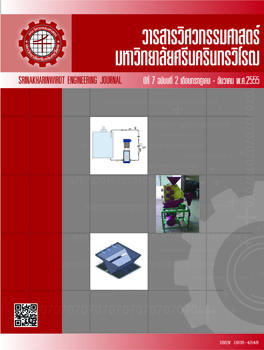Transpiration Cooling System in Al-Co Open-celled Foam having PPI of 13
Abstract
One-dimensional transpiration cooling system in open-celled foam has been conducted experimentally and numerically to investigate the heat transfer characteristics of combined convection and radiation. The Alumina–Cordierite (Al-Co) open-cell foam having porosity of 0.87 and pores per inch (PPI) of 13 was employed. The upper surface of porous plate was heated by the heat flux of incoming radiation (qRx,f) varying from 0.97 - 16.59 kW/m2 whereas air injection velocity (uf) fed into the lower surface was varied from 0.364 - 1.274 m/s, and then uf was converted as Reynolds number (Re). The results show that the temperature efficiency (hT), indicating how close the mean temperature of a porous heat plate to that of inlet air, increased rapidly with the air injection velocity (Re). It was then saturated and had a constant value at Re higher than 30. The conversion efficiency (hC), which was regarded as the ability of porous material in transferring energy by convection after absorbed from heat radiation, decreased slightly with increasing of qRx,f and uf (Re). The numerical predictions also agreed well with experimental data. Keyword: Open-cell foam, Radiation, Transpiration cooling, Reynolds numberDownloads
Download data is not yet available.
Downloads
Published
2012-12-11
Issue
Section
บทความวิจัย
License
ลิขสิทธิ์เป็นของวารสารวิศวกรรมศาสตร์ มหาวิทยาลัยศรีนครินทรวิโรฒ





